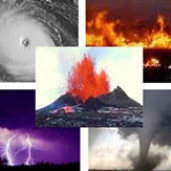
As of 2022, the World Nuclear Association says there are 430+ operable commercial nuclear reactors with over 90 of them in the United States, and 19 power stations in Canada so millions of Americans and Canadians live within 10 miles (16 km) of an operating power plant. Also WNA reports there are 220 research reactors (50 in the U.S.) mainly on university campuses.
Even though governments and associations monitor and regulate construction and operation of plants, accidents are possible and do happen. An accident could result in dangerous levels of radiation that could affect the health and safety of the public living near a nuclear power plant, as well as people many miles away depending on winds and weather – so tens of millions of North Americans could potentially be affected.
Some other incidents involving possible radiation exposure may be a nuclear missile or suitcase nuke or a dirty bomb.
How is radiation detected?
You
cannot see, feel, taste or smell radiation, but special instruments can
detect even the smallest levels of it. If radiation is released,
authorities will monitor levels of radioactivity to determine the
potential danger so they can alert and protect the public. (Consider
getting dosimeters [pen units, RADTriage, etc], KFM kits or NukAlerts
for your personal kits to detect radiation levels.)
What is best way to reduce radiation exposure?
Limit the amount of radiation you are exposed to by doing 3 things …
Distance
– The more distance between you and the source of radiation, the less
you’ll receive. During a serious accident you may be told to evacuate.
Shielding
– Heavy, dense materials between you and radiation is best – this is
why you want to stay indoors since the walls in your home should be good
enough to protect you in some cases… but listen to radio and TV to
learn if you need to evacuate.
Time – Most
radioactivity loses its strength rather quickly. Limiting your time near
the source of radiation reduces the amount you receive.
What is the most dangerous part of a nuclear accident?
Radioactive iodine – nuclear reactors contain
many different radioactive products, but a dangerous one is radioactive
iodine, which once absorbed, can damage cells of the thyroid gland. The
greatest population that suffers in a nuclear accident is children
(including unborn babies) since their thyroid is so active, but all
people are at risk of absorbing radioactive iodine.
How can I be protected from radioactive iodine?
Potassium iodide (KI) – can be purchased
over-the-counter now and is known to be an effective thyroid-blocking
agent. In other words, it fills up the thyroid with good iodine that
keeps radioactive iodine from being absorbed into our bodies.
What if I am allergic to iodine?
According to the United States Nuclear Regulatory Commission Office
of Nuclear Material Safety and Safeguards, the FDA suggests that risks
of allergic reaction to potassium iodide are minimal compared to
subjecting yourself to cancer from radioactive iodine. Ask your doctor
or pharmacist what you should keep on hand in the event of an allergic
reaction.
Many countries stockpile potassium iodide (KI),
especially since the Chernobyl and Fukushima Daiichi incidents. Several
U.S. states also stockpile KI in case of an accident or incident, but
people would have to wait for it to be disseminated so consider
acquiring some for your various kits.
The FDA has approved 4 KI products – Iosat, ThyroSafe, ThyroShield and Potassium Iodide Oral Solution USP per www.cdc.gov. In an emergency, other options may be taking KIO3, applying iodine solution to your skin, or taking kelp pills.
Community Planning for Emergencies
Local, state and provincial governments, Federal agencies and
utilities have developed emergency response plans in the event of a
nuclear power plant accident. United States’ plans define 2 “emergency
planning zones” (EPZs)
• Plume Exposure EPZ – a
10-mile radius from nuclear plant where people may be harmed by
radiation exposure NOTE: People within a 10-mile radius are given
emergency information about radiation, evacuation routes, special
arrangements for handicapped, etc. via brochures, phone books, and
utility bills.
• Ingestion Exposure EPZ – about a
50-mile radius from plant where accidentally released radioactive
materials could contaminate water supplies, food crops and livestock
BEFORE A NUCLEAR POWER PLANT EMERGENCY:
Learn the buzzwords – Know terms used to describe a nuclear emergency at a plant: U.S. / (Canada)…
- Notification of Unusual Event / (Reportable Event) – a small problem has occurred. No radiation leak is expected. Federal, state/provincial and county/municipal officials will be told right away. No action on your part will be necessary.
- Alert / (Abnormal Incident) – a small problem has occurred, and small amounts of radiation could leak inside plant. This will not affect you and you shouldn’t have to do anything.
- Site Area Emergency / (Onsite Emergency) – a more serious problem… small amounts of radiation could leak from the plant. If necessary, officials will act to ensure public safety. Area sirens may be sounded and listen to your radio or TV for information.
- General Emergency / (General Emergency) – the MOST serious problem… radiation could leak outside the plant and off the plant site. In most cases sirens will sound so listen to local radio or TV for reports and updates. State/Provincial and county/municipal officials will act to assure public safety and be prepared to follow their instructions!
Learn signals – Ask about your community’s
warning system and pay attention to “test” dates to learn if you can
HEAR it. Nuclear power plants are required to install sirens and other
warning devices to cover a 10-mile area around the plant in the U.S. (If
you live outside the 10-mile area you will probably learn of the event
through local TV and radio, but just be aware winds and weather can
impact areas as far as 200 miles [320 km] away!!)
Learn risks – Ask the company operating the plant for brochures and data.
Make a plan
– Develop a Family Emergency Plan and Disaster Supplies Kit. Double
check on emergency plans for schools, day cares or places family may be
and where they’ll go if evacuated.
DURING A NUCLEAR POWER PLANT EMERGENCY:
Stay calm – Not all accidents release radiation – may be contained in plant.
Listen – Turn on radio or TV. Authorities will give specific instructions and information for each specific incident.
Stay or go..? – Evacuate if told to do so by local authorities … and …
- Grab your Disaster Supplies Kit.
- Close doors, windows and fireplace damper.
- Cover your mouth and nose with face mask or cloth.
- Close car windows and vents and use “re-circulating” air.
- Keep listening to radio for evacuation routes & updates.
As long as you are NOT told to evacuate, do the following…
IF INDOORS – Stay inside and prepare to “shelter-in-place”…
- Close doors and windows and your fireplace damper.
- Turn off air conditioner, ventilation fans, furnace and other intakes (they pull in air from outside).
- Go to a basement or underground area (if possible).
- Keep a battery-operated radio with you to hear updates.
- Stay inside until authorities tell you it is safe to go out!
IF OUTDOORS – Get indoors as soon as possible!
- Cover mouth and nose with a cloth or napkins and find shelter.
- Once inside, remove clothing, shower & wash hair and put on fresh clothing and different shoes. Put clothes and shoes you were wearing in plastic bags, seal and store. Local authorities can tell you what to do with bags.
IF IN A VEHICLE – Keep windows up, close vents,
use “recirculating” air and keep listening to radio for updates. If
possible, drive away from site.
Pets & livestock
– Get them in shelters with clean food and water that has not been
exposed to air-borne radiation, especially milk-producing animals.
Food – Put food in covered containers or in refrigerator — any food that was not in a covered container should be washed first.
Take potassium iodide..?
– IF radioactive iodine has been released into the air from a power
plant accident, some states may decide to provide KI pills mentioned at
beginning of this topic to people in a 10-mile radius.
NOTE: Take KI pills ONLY as directed by local public health authorities and follow instructions on the package exactly!
AFTER A NUCLEAR POWER PLANT EMERGENCY:
Listen – Keep radio and TV tuned in — stay in until authorities say all clear.
Clean up – If you were possibly exposed to radiation…
- store clothes & shoes – put clothing and shoes in tightly sealed containers or plastic bags and ask health officials what to do with them
- shower – wash your body and hair to remove radioactive particles
- land and property – ask authorities how to clean up area
Weird symptoms – Seek medical attention if you have
symptoms like upset stomach or feel queasy after a reported incident
since it could be related to radiation exposure.
Gardens & crops
– Authorities will provide information concerning safety of farm and
homegrown products — or check with agricultural extension agent.
Unharvested crops are hard to protect but crops that are already
harvested should be stored inside, if possible.
Milk – Local officials should inspect cows’ and goats’ milk before using.
Some other incidents involving possible radiation exposure may be a nuclear missile or suitcase nuke or a dirty bomb.
Learn how to order USFRA's 286-page Family Preparedness and first aid ebook with more safety information about radiological and nuclear emergencies and much more.
Source: It’s A Disaster!

